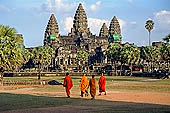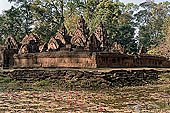| enter keyword to search: |
|
Images db
|
|
|
Articles db
|
|
|
|
|
|
|
|
|
Meaning ‘the city’ or ‘the capital’ in the ancient Khmer language, Angkor is the modern name given to a complex of cities, Hindu and Buddhist temples, and reservoirs located in the fertile plain between the Kulen Hills and Tonlé Sap. Here between the ix and xiii c. A.D. a dozen of Khmer kings constructed their successive capitals together with a sophisticated irrigation system and a multitude of temples.
Angkor Wat |

|
Several religious movements contributed to the architectural development of Angkor.
the Lingam and the Devaraja cult (ix / xi century)
King Jayavarman II (800 A.D.) marks the beginning of the Angkorian period. At
that time Harihara cult (Vishnu Shiva deity) was much favoured, the epithet “devaraja” (god-king) was adopted
for the king which, through the worship of the lingam, was identified with Shiva.
This period, Shivaism was the state religion, was marked by changes in religious architecture. The single-chambered sanctuaries, typical of previous architecture, give way to the temple mountain: a pyramid made of raised platforms bearing on top the quincunx towers. Increasingly impressive temple pyramids came to represent Mount Meru, the home of the Hindu gods, with
the moats surrounding the temples representing the mythological oceans. Influenced by Javanese architecture the pyramid temple of
Bakong 'the mountain of the king of the gods' was the main monument of Roluos the kingdom capital.
Eastern Mebon, another typical example of temple mountain, built in the centre of the now dry East Mebon
is a clear symbolism of the Mount Meru, and, on the same north south axis,
Pre Rup in a similar style. Of this period are also the Prasat Kravan towers with unique Vishnu and Lakshmi bas-reliefs close by the
Sra Srang baray, and the rose sandstone miniature jewel Banteay Srei with exquisite bas reliefs.
In the xi century Angkor reaches its present layout.
Ta Keo an imposing five tiers temple mountain, Phimeanakas a three tiers pyramid and at the centre of the royal city the three tiered
Baphuon.

|
Bayon
|
Vaishnavism (xii century)
Angkor becomes a vast royal city with palaces, canals, reservoirs and temples. At the beginning of the xii c. with the construction of
Angkor Wat, the largest known religious monument and King Suryavarman II personal mausoleum, the worship of Vishnu become predominant: the central religious image of Angkor Wat was an image of Vishnu. Religious syncretism, however, remained and the turn to Vaishnavism did not abrogate the king cult, venerated was not the Hindu deity but the king Suryavarman II himself identified with Vishnu.
Other important constructions of Suryavarman II reign are: the couple Thommanon and
Chau Say Tevoda temples in similar style; the finely proportioned temple of
Banteay Samre, reconstructed with anastylosis.
Banteay Srei |

|
Mahayana Buddhism
In the last quarter of the xii c. King Jayavarman VII, Angkor’s greatest ruler, adopted Mahayana Buddhism as his personal faith. During his kingdom the empire stretched from Thailand to the borders of Myanmar, into northern Vietnam and south into Malaya. Jayavarman’s most famous temple is the Buddhist
Bayon at the heart of his new capital city of Angkor Thom with the famous face towers where the king represented himself as the bodhisattva Avalokiteshvara. Thus, Jayavarman perpetuated the king cult identifying himself with the bodhisattva rather than with Shiva or Vishnu. The royal palace was located in a separate walled precinct within the Elephant Terrace. Of the same period are
Ta Prohm, Banteay Kdei, Preah Khan, and the island temple of
Neak Pean in the middle of the Northern Baray.

|
Preah Khan
|
Hindu restoration and the decline (xiii century)
In the course of the xiii c. the Hindu restoration began with king Jayavarman VIII a Shivaite iconoclast specialized in destroying Buddhist images and in re-establishing the Hindu shrines previously converted to Buddhism. Lately coming from Siam (Thailand) Theravada Buddhism made its appearance, gradually becoming the dominant religion of Cambodia, although both Mahayana Buddhism and
Shivaism were still present.
The Khmer Empire began to decline, Angkor was abandoned and much of the site was then overgrown by the jungle, used only intermittently over the years by Buddhist monks. The practice of Theravada Buddhism at Angkor continues until these days.
Following rediscovery by the western world in the xix c., much of Angkor was restored in the xx c. In 1992, the
UNESCO paid recognition to the present-day archaeological park, covering 400 km2.
| |
|
|
 |
|
|



